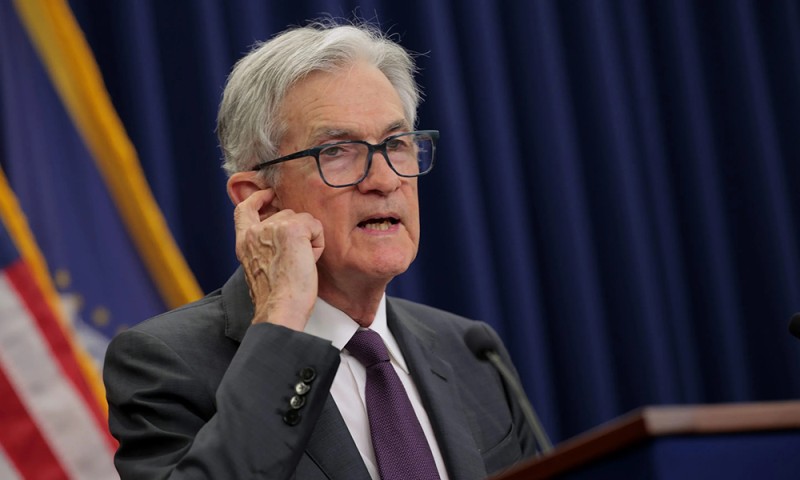
随着美国劳动力市场出现明显停滞迹象,一位华尔街顶级策略师发出严厉警告:由于美国劳动力面临人口结构危机,且移民政策正经历历史性变革,“未来五年出现劳动力零增长的概率极大”。
据摩根大通资产管理公司(JPMorgan Asset Management)首席全球策略师大卫·凯利(David Kelly)称,这对美联储和投资者都将产生极为深远的影响——其中最为关键的是,在降息前须慎之又慎。
凯利在其定期发布的《下周展望》研究报告中,对上周五令人震惊的就业报告所带来的影响进行了分析——或许是在评估其造成的损害。该报告将5月和6月的新增就业岗位数量向下修正了25.8万个。此外,雇主在7月仅新增7.3万个就业岗位,远低于11万的一致预期。这使得过去三个月的月均新增岗位数量仅为3.5万个。7月失业率小幅上升至4.2%,就业人数和劳动力参与率进一步下滑。
凯利还指出劳动力市场趋紧的迹象:劳动力参与率从2024年7月的62.65%下滑至2025年7月的62.22%。这意味着16岁及以上人群中,有近120万人不再就业或积极寻找工作。
他将这一降幅的大约一半归因于美国人步入退休年龄,但指出18至54岁人群的劳动参与率也出现了下滑态势。
凯利就这些劳动力紧缺迹象发表评论,指出它们是理解经济中劳动力供应这一更广泛问题的关键背景要素。从长期趋势来看,美联储及其备受压力的主席杰罗姆·鲍威尔未来将面临抗击通胀的重大挑战——这意味着市场翘首以盼的关键降息机会正变得愈发渺茫。
经济中的劳动力问题
人口老龄化与劳动参与率下滑,还反映出一个更深层次的结构性挑战,这一挑战将在未来长期存在。
他指出,根据人口普查预测,若移民数量无法恢复到以往水平,未来数年劳动年龄人口实际上将会出现缩减。
凯利强调了人口普查预测:在截至2026年7月的一年间,18至64岁人口将减少逾30万人,且到2030年,这一年龄段的人口规模还将以大致相同的速度持续缩减。他指出,退休潮的涌现,加上近期对主要移民项目的调整,进一步削弱了劳动力供应,拉低了潜在的增长率。
美联储的困境:通胀、增长与政治压力
在这种劳动力市场紧缩局面出现之时,美联储正承受着要求降息的巨大政治压力。特朗普及其盟友呼吁放松货币政策,以此抵消新关税带来的影响,并为疲软的市场提供支撑。
然而,凯利认为,美联储必须谨慎行事,因为在劳动力市场结构性紧张的情况下降息,可能会引发工资和物价通胀,而非促进经济增长。
他观察到,自21世纪以来,美国经济年均增长2.1%,这在很大程度上得益于劳动力年均0.8%的增长。
“考虑到婴儿潮一代不断步入退休阶段,且未来数年移民驱逐和自愿离境可能完全抵消新移民的流入,在当前接近充分就业的情况下,未来五年出现劳动力零增长的概率极大。”他补充道。
凯利预测,若此情形发生,经济增速将会放缓,“并且唯有在不引发更高通胀的条件下,才能达成这种增速放缓的局面”。
他补充道,对于美联储而言,信号很明确:对于任何降息举措都务必慎之又慎。对投资者而言,这无疑是一个警示,提醒他们要对快速经济增长或由宽松货币政策推动的持续牛市预期保持审慎态度。换言之,美国“例外论”在未来绝非是顺理成章之事。
凯利表示,投资者“不应再普遍押注于美国经济强劲复苏或利率下调”。(*)
《财富》杂志使用生成式AI辅助完成本文的初稿。编辑在发布前已核实信息的准确性。
译者:中慧言-王芳
随着美国劳动力市场出现明显停滞迹象,一位华尔街顶级策略师发出严厉警告:由于美国劳动力面临人口结构危机,且移民政策正经历历史性变革,“未来五年出现劳动力零增长的概率极大”。
据摩根大通资产管理公司(JPMorgan Asset Management)首席全球策略师大卫·凯利(David Kelly)称,这对美联储和投资者都将产生极为深远的影响——其中最为关键的是,在降息前须慎之又慎。
凯利在其定期发布的《下周展望》研究报告中,对上周五令人震惊的就业报告所带来的影响进行了分析——或许是在评估其造成的损害。该报告将5月和6月的新增就业岗位数量向下修正了25.8万个。此外,雇主在7月仅新增7.3万个就业岗位,远低于11万的一致预期。这使得过去三个月的月均新增岗位数量仅为3.5万个。7月失业率小幅上升至4.2%,就业人数和劳动力参与率进一步下滑。
凯利还指出劳动力市场趋紧的迹象:劳动力参与率从2024年7月的62.65%下滑至2025年7月的62.22%。这意味着16岁及以上人群中,有近120万人不再就业或积极寻找工作。
他将这一降幅的大约一半归因于美国人步入退休年龄,但指出18至54岁人群的劳动参与率也出现了下滑态势。
凯利就这些劳动力紧缺迹象发表评论,指出它们是理解经济中劳动力供应这一更广泛问题的关键背景要素。从长期趋势来看,美联储及其备受压力的主席杰罗姆·鲍威尔未来将面临抗击通胀的重大挑战——这意味着市场翘首以盼的关键降息机会正变得愈发渺茫。
经济中的劳动力问题
人口老龄化与劳动参与率下滑,还反映出一个更深层次的结构性挑战,这一挑战将在未来长期存在。
他指出,根据人口普查预测,若移民数量无法恢复到以往水平,未来数年劳动年龄人口实际上将会出现缩减。
凯利强调了人口普查预测:在截至2026年7月的一年间,18至64岁人口将减少逾30万人,且到2030年,这一年龄段的人口规模还将以大致相同的速度持续缩减。他指出,退休潮的涌现,加上近期对主要移民项目的调整,进一步削弱了劳动力供应,拉低了潜在的增长率。
美联储的困境:通胀、增长与政治压力
在这种劳动力市场紧缩局面出现之时,美联储正承受着要求降息的巨大政治压力。特朗普及其盟友呼吁放松货币政策,以此抵消新关税带来的影响,并为疲软的市场提供支撑。
然而,凯利认为,美联储必须谨慎行事,因为在劳动力市场结构性紧张的情况下降息,可能会引发工资和物价通胀,而非促进经济增长。
他观察到,自21世纪以来,美国经济年均增长2.1%,这在很大程度上得益于劳动力年均0.8%的增长。
“考虑到婴儿潮一代不断步入退休阶段,且未来数年移民驱逐和自愿离境可能完全抵消新移民的流入,在当前接近充分就业的情况下,未来五年出现劳动力零增长的概率极大。”他补充道。
凯利预测,若此情形发生,经济增速将会放缓,“并且唯有在不引发更高通胀的条件下,才能达成这种增速放缓的局面”。
他补充道,对于美联储而言,信号很明确:对于任何降息举措都务必慎之又慎。对投资者而言,这无疑是一个警示,提醒他们要对快速经济增长或由宽松货币政策推动的持续牛市预期保持审慎态度。换言之,美国“例外论”在未来绝非是顺理成章之事。
凯利表示,投资者“不应再普遍押注于美国经济强劲复苏或利率下调”。(*)
《财富》杂志使用生成式AI辅助完成本文的初稿。编辑在发布前已核实信息的准确性。
译者:中慧言-王芳
As the U.S. labor market shows clear signs of stalling, one of Wall Street’s leading strategists is sounding a sharp warning: With America’s workforce in a demographic crunch and historic changes in immigration policy underway, it is “quite possible that the next five years will see no growth in workers at all.”
The implications, according to David Kelly, chief global strategist at JPMorgan Asset Management, are profound for the Federal Reserve and for investors—chief among them, the need for exceptional caution before lowering interest rates.
Kelly used his regular “Notes on the Week Ahead” research note to survey the implications—perhaps assess the damage—of Friday’s shocking jobs report, which revised downward job creation in May and June by 258,000 jobs. Furthermore, employers added just 73,000 jobs in July, well below the 110,000 consensus estimate. This left the average monthly increase for the past quarter at a paltry 35,000 jobs. The unemployment rate ticked up to 4.2% in July, as both employment numbers and labor force participation slipped further.
Kelly also highlighted signs of tightness in the labor market, namely the decline in the labor participation rate from 62.65% in July 2024 to 62.22% in July 2025. That translates to almost 1.2 million fewer people ages 16 and over who are working or actively looking for a job.
He attributed about half this decline to Americans aging into retirement, but noted the participation rate has also fallen among those ages 18 to 54.
Kelly commented on these signs of labor tightness as pivotal context for the wider question of the labor supply in the economy, with long-running trends implying that the Federal Reserve and embattled Chair Jerome Powell will face major challenges fighting inflation going forward—meaning ever-slimmer chances of the all important rate cut the market wants so much.
The worker problem in the economy
The aging population and declining labor participation also speak to a deeper, structural challenge that will persist well into the future.
According to Census projections, he noted the working-age population will actually contract in coming years without immigration returning to previous levels.
Kelly highlights the Census prediction that the population ages 18 to 64 would actually fall by over 300,000 people in the year ending July 2026, and continue to fall at roughly that pace through 2030. He notes that the retirement wave and recent changes to major immigration programs are further sapping labor supply, reducing potential growth.
Fed’s dilemma: inflation, growth, and political pressure
This squeeze comes at a time when the Federal Reserve is under immense political pressure to lower interest rates, with President Trump and his allies calling for easier money to offset the effects of new tariffs and support flagging markets.
Yet Kelly argues the central bank must tread carefully, as cutting rates into a structurally tight labor market risks spurring wage and price inflation rather than accelerating economic growth.
He observed that U.S. economic growth has averaged 2.1% per year since the beginning of the 21st century, largely driven by a 0.8% annual increase in the workforce.
“Starting from a point of roughly full employment, given the continued retirement of the baby boom and considering the possibility that deportations and voluntary departures of immigrants entirely offset new immigration in the next few years, it is quite possible that the next five years will see no growth in workers at all,” he added.
If this happens, the economy will grow more slowly, Kelly predicted, “but will only be capable of growing more slowly without igniting higher inflation.”
For the Fed, the message is clear, he adds: Be extremely cautious about any rate cuts. For investors, it’s a warning to temper expectations for rapid economic gains or a sustained bull market driven by easy money. In other words, American “exceptionalism” isn’t a given, going forward.
Investors, Kelly said, “should no longer bet broadly on a strongly rising U.S. economic tide or lower interest rates.”
For this story, Fortune used generative AI to help with an initial draft. An editor verified the accuracy of the information before publishing.

